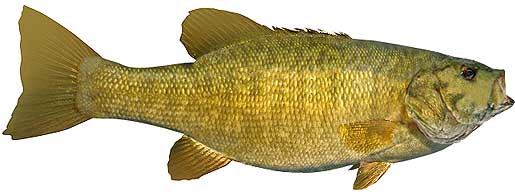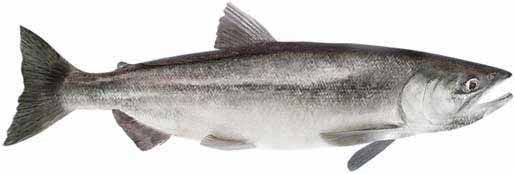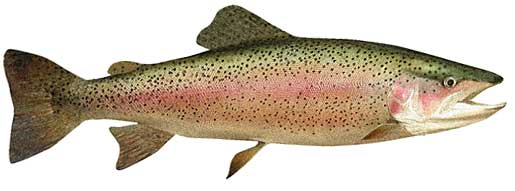Fishing Report For Dworshak Reservoir, ID
By Rick Seaman
Last updated on .

Fishing Reports
Popular Fish Species Dworshak Reservoir, ID
Smallmouth Bass
Current Report: Good To Very Good
Dworshak Reservoir is widely-known as an exceptional trophy smallmouth bass fishery. Many smallies weighing 5 pounds or more, are consistently caught each year, with the lake record well over 9 pounds.
FALL. Fall is in full swing and smallmouth have followed schools of baitfish into coves and bays 8 to 20 feet deep. They thrive in the cold, clean water, which is an ideal environment for them. Locals report that tube jigs are a great choice when the bass are around 15 feet deep. Drop shot rigs with small worms or shad shaped plastics are also popular in 10' water or deeper. Jerkbaits, deep-diving crankbaits, and slow-rolled spinnerbaits, are also successful, when bass are shallow to mid depth. Later in Fall, smallies move to slightly deeper water, around 10 to 25 feet deep. Fishing shallow for smallmouth is often good on cold, windy, cloudy and rainy days.
WINTER. Winter will isolate them around deeper structure, points, flats and creek channels, often suspending in open water above these features. They can generally be found from 10 to 30 feet deep. Jigging spoons, tube baits, drop-shot worms, jigs and Ned rigs tend to temp smallmouth in deep water. I like to work these deeper haunts very slowly, as the bass are somewhat sluggish. Here they hold, feeding less frequently, awaiting warmer water to return in Spring.
SPRING. After ice out, when water temperatures rise into the 50's, smallmouth move from deep wintering spots to shallower water, just outside spawning areas. They feed heavily in 4 to 12 feet of water at this time, and are typically caught on jerkbaits, crankbaits, tube baits, Ned rigs, and crayfish imitating plastics. Once water warms into the high 50's, they move into shallower water, and create nests in gravel or sand areas, then lay their eggs. Females then move to deeper water and males remain to guard the eggs, and then the fry. After a couple weeks, the males also move into 15 to 20 feet deep, and feed aggressively. Crankbaits, tube baits, Ned rigs, plastic worms, spoons and swimbaits are catching smallies during this period.
SUMMER. Smallmouth bass are currently feeding shallow early and late in the day in 2 to 12 feet of water. They are being caught on topwater, crankbaits, swimbaits, Ned rigs and tube baits. Smallmouth bass here feed on crawfish, gizzard shad, and small sunfish. They prefer rocky or gravel bottom areas, as this is where crayfish live. During the hotter parts of the day, they are being caught on points, humps, and ledges around 20 to 25 feet deep. Often these deeper fish tend to school, so finding them can deliver some fast action.
Kokanee Salmon
Current Report: Fair
Due to complication of an over populated fishery, kokanee are running smaller now than in previous years. Prospects do look good for the future, so this year could be a good time to chase down some quality kokanee.
FALL. During Fall, kokanee migrate into spawning grounds, which can be along the shoreline of the lake, or upstream in rivers and tributaries. In the weeks just prior to the spawn, they will gather in sizeable schools near the mouths of these inflows. The spawn typically occurs in mid to late September. Kokanee fishing is good from 8 to 20 feet deep. Casting or trolling spinners, spoons, or kokanee rigs works well during the spawn.
WINTER. In Winter, kokanee school up and hang out over deep water, most often above some type of structure. Their ideal water temperature is mid to low 50's. Identify the depth for that temperature range, and the kokanee will be hanging out in that depth range. Worm harnesses and wedding ring spinner setups are popular when trolled behind a 4" dodger. Locals are tipping these baits with shoepeg white corn, PowerBait, Z-Man Scented ShrimpZ, or live nightcrawlers. Experiment with depth, 15 to 30 feet deep is the ideal range. Trolling these baits between 1.2 mph and 1.8 mph is a good speed for these kokes.
SPRING. During late Spring kokanee typically move close to the surface where phytoplankton blooms become more abundant, providing a rich food source. Locals concentrate in the area around Dent in Spring through July. Kokanee will feed heavily on this plankton until surface temperatures reach the high 50's. Kokanee stage in tributary mouths, upper river arms, and warmer, food-rich pockets as they begin to move toward spawning reaches. Casting or trolling spinners, spoons, or kokanee rigs works well during this period.
SUMMER. Downriggers or leaded line are the two primary methods for catching kokanee here, while trolling. Kokanee school up and hang out over deep water, usually above some type of structure. The ideal water temperature is mid to low 50's. Identify the depth for that temperature range, and the kokanee will be hanging out in that depth range. Worm harnesses and wedding ring spinner setups are popular when trolled behind a 4" dodger. Locals are tipping these baits with shoepeg white corn, PowerBait, Z-Man Scented ShrimpZ, or live nightcrawlers to helps attract bites. 15 to 30 feet deep is the ideal depth to work in these warmer months. Trolling these baits between 1.2 mph and 1.8 mph is a good speed for these kokes. PowerBait, Z-Man Scented ShrimpZ and scented shoepeg corn, spoons and kokanee spinner rigs are all working well for slow drifting, or trolling.
Rainbow Trout
Current Report: Good To Very Good
10,000 catchable rainbow trout are stocked each year to maintain a great trout fishery for anglers.
FALL. Cooling water temperatures in the shallows, draw rainbow trout out of deeper Summer depths. Anglers are now catching them 20 to 25 feet deep on rocky banks, wind-blown points, rocky structure, humps, and anywhere baitfish are gathering. Now that they had a full summer to grow, there are some nice size rainbow to be caught. Small spinners, spoons, jigs, miniature crankbaits and swimbaits are good choices, as are salmon eggs and prepared baits. Later in Autumn, they move into 25 to 30 feet of water.
WINTER. When Winter sets in jigging spoons, and jigs tipped with bait, are catching nice limits of rainbows out of 25 to 35 feet of water. These baits work well around the old river channels and the deeper humps and cuts. Trolling with leaded line or downriggers, or vertical jigging with spoons and jigs, are the best approach during the cold-water season. Slowly worked offerings are more likely to attract bites in this cold water.
SPRING. As water begins to warm in early Spring, rainbow trout move from their late winter holding areas to shallow, warmer water 4 to 10 feet deep. A good number of rainbows are typically caught from mid morning to late afternoon, during the warmest water of the day. Shallow flats and rocky structure are quick to warm in the afternoon sun. A wide variety of small spinners, spoons and bait are catching most of the fish. Later in Spring rainbows drop into 12 to 18 feet of water.
SUMMER. Once Summer is here to stay, the warmer water drives rainbow deeper, 15 to 40 feet deep, occasionally deeper. Trolling with spoons, spinners and crankbaits, using downriggers or leaded line, and drift fishing with bait, are currently the most productive methods. During the middle of the day, focus on structure 30 feet deep. next to drop offs. Following drop-offs into deeper water, along structure or creek channels, is a major key to getting bites. Anglers fishing from the bank are using nightcrawlers or Berkley PowerBait, with heavy weights on a Carolina rig, to get baits in deeper water.
Fishing Video
Fish species to fish for...
Guide to fishing for smallmouth bass, black crappie, rainbow trout, cutthroat trout, kokanee salmon and steelhead at Dworshak Reservoir in Idaho.
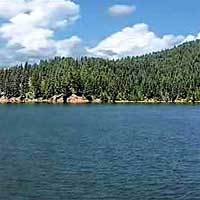 Dworshak Reservoir is 50 miles long, covers 16,500 surface acres, and has 175 miles of shoreline. This lake is home to kokanee salmon, rainbow trout, smallmouth bass, crappie and catfish. Shoreline fishing is available along sections of the roads that run close to the lake, and at both ends of Dent Bridge.
Dworshak Reservoir is 50 miles long, covers 16,500 surface acres, and has 175 miles of shoreline. This lake is home to kokanee salmon, rainbow trout, smallmouth bass, crappie and catfish. Shoreline fishing is available along sections of the roads that run close to the lake, and at both ends of Dent Bridge.
Primary fish species to catch
Click images for fishing tips and details about each species.


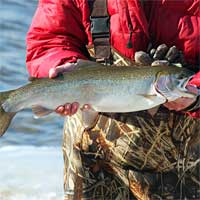



Today's Weather & Forecast
Public Boat Launch Ramps & Landings
Click here for boat ramps.
Marinas
Click here for marinas.
Fishing License
Click here for a Idaho Fishing License.
Map - Fishing & Access
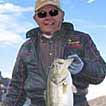 Rick Seaman is a fishing enthusiast with over five decades of fishing experience, a retired tournament fisherman, author of numerous published articles on fishing, and co-author of the book "Bass Fishing - It's not WHAT you throw, It's WHERE you throw it".
Rick Seaman is a fishing enthusiast with over five decades of fishing experience, a retired tournament fisherman, author of numerous published articles on fishing, and co-author of the book "Bass Fishing - It's not WHAT you throw, It's WHERE you throw it".
 Contact Information
Contact Information
Dworshak State Park
9934 Freeman Creek
Lenore, ID 83541
888 922-6743
Fishing lakes in each state
111225
Dworshak Reservoir, Idaho Report
IDAHO


Information about fishing lakes in Idaho
Dworshak Reservoir offers trout, salmon, steelhead, crappie and bass fishing in northwest Idaho.


